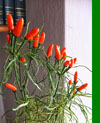GLOSSARY:
CGN: This symbol indicates that the cultivar referred to by that name is listed in the Database of the genebank at Wageningen in the Netherlands.
CAP: This symbol indicates that the cultivar is present in the database of the German Research Centre for Biotechnology (Braunschweig, Germany).
PI: It is the acronym that refers to the Plant Introduction number, a number assigned in the classification system of the USDA (United States Department of Agriculture Research Service).
GRIF: It is the acronym that refers to the Germplasm Repository Institute Fundation, a number assigned in the USDA (United States Department of Agriculture Research Service) classification system.
BGH: It is the acronym that refers to the Banco de Germoplasma de Hortaliças, Brazil.
Var: Is an abbreviation of the Latin "varietas" and simply means the variety. This is not the variety as we understand commonly, ex: Red Savina Habanero, that would be more properly called "cultivar" and is a term used in the production of hybrids (breeding), not in botany. The botanical variety with the "subspecies" and "form" is one of the possible categories below the species. In the genus Capsicum, there are no subspecies or forms, but only a few varieties. Ex: C.annuum var glabriusculum, C.baccatum var baccatum, C.villosum var muticum, etc..
Sp. Spp. : The indications Capsicum sp. and Capsicum spp. indicate one or more species not determined. In the research expedition in 1999, the Brazilian botanists assigned to populations of wild Capsicum found in the south-east of Brazil provisional identification Capsicum sp. followed by numbers from 1 to 9.
 Jacq. : Is the standard abbreviation used for plants described by Nikolaus Joseph von Jacquin (Leiden, February 16, 1727 - Vienna, 26 October 1817), medical, chemical and Dutch botanist.
Jacq. : Is the standard abbreviation used for plants described by Nikolaus Joseph von Jacquin (Leiden, February 16, 1727 - Vienna, 26 October 1817), medical, chemical and Dutch botanist.
 L. : Is the standard abbreviation used for plants described by Linnaeus. Nilsson Carl Linnaeus (Råshult, May 23, 1707 - Uppsala, 10 January, 1778) was a physician, botanist and Swedish naturalist considered the father of modern scientific classification of living organisms.
L. : Is the standard abbreviation used for plants described by Linnaeus. Nilsson Carl Linnaeus (Råshult, May 23, 1707 - Uppsala, 10 January, 1778) was a physician, botanist and Swedish naturalist considered the father of modern scientific classification of living organisms.
 Ruiz & Pav. : Hipólito Ruiz López and José Antonio Pavón Jiménez were two Spanish botanists that between 1779 and 1788 participated in the first of three expeditions in Peru and Chile and other South American countries. Are jointly cited as authors of several botanical names including the C. pubescens. Their abbreviations are Ruiz & Pav.
Ruiz & Pav. : Hipólito Ruiz López and José Antonio Pavón Jiménez were two Spanish botanists that between 1779 and 1788 participated in the first of three expeditions in Peru and Chile and other South American countries. Are jointly cited as authors of several botanical names including the C. pubescens. Their abbreviations are Ruiz & Pav.
Sendtn. : Is the standard abbreviation used for plants described by Otto Sendtner (Monaco of Bavaria, June 27, 1813 - Erlangen, April 21, 1859) German botanist.
Cultivar: We use the term cultivar to indicate the differences between the various crop plants or in reference to the result of crossbreeding of plants with intent and not natural.
Variety: There is talk of variety if the differences are already present in nature.Subspecies: To subspecies indicates a plant that grows in a certain region or a certain habitat.
Form: This term is used to indicate the difference between plants of the same species in terms of growth.
Hybrids: Hybrids are plants raised by crossing different species; usually hybridization occurs between plants of the same genus.
 Endemic: The term endemic is used, too, for those plants or animals that live only in a given territory. The term endemism was used for the first time in botany in 1820 by the Swiss naturalist Augustin Pyramus de Candolle, who recovered from medical terminology.
Endemic: The term endemic is used, too, for those plants or animals that live only in a given territory. The term endemism was used for the first time in botany in 1820 by the Swiss naturalist Augustin Pyramus de Candolle, who recovered from medical terminology.
Cumari: Cumari is a generic term that in South America it refers to any species of Capsicum, usually wild, which has small berries and easy to peel off. This feature means that they are eaten by birds. Cumari The name comes from the Tupi Indian language, meaning "the pleasure of taste" in reference to the use as a condiment.
Bird pepper: Bird pepper is a generic term, which in North America, refers to any species of Capsicum, usually wild, which has small berries and easy to peel off. This feature means that they are eaten by birds, hence the name.
ASTA: American Spice Trade Association, was founded in 1907 and represents the interests of approximately 175 members, including companies that cultivate and work the spices. The members of ASTA include American agents, brokers, importers and companies spices headquartered outside of the United States that export to the United States and other companies associated with the field of spices in the United States. ASTA members produce and market most of the spices sold in the United States for industrial, food service and ordinary consumers.
USDA: The Department of Agriculture of the United States is a federal department created in February 1889 by President Grover Cleveland. It aims to meet the needs of farmers, promote agricultural trade and production, ensure food safety, protect natural resources and rural communities.
CURIOSITY:
The capsaicin was discovered in 1816 by Christian Friedrich Bucholz, who isolated the substance from hot chillies macerated using organic solvents. The method is still used to pull the oleoresin from chillies. In 1846 L.T. Thresh the synthesized in crystalline form, and baptized capsaicin. In 1878 he also won the Hungarian Endre Hogyes capsaicin crystals, which he called capsicolo and showed that capsaicin stimulates the mucous membranes of the mouth and stomach, increasing the production of gastric juices.
Resiniferatoxin: The resiniferatoxin is a substance similar to capsaicin ultrapiccante you get dall'Euphorbium, a resin derived from a plant similar to a cactus, Euphorbia resinifera, originally from Morocco and well known to the Greek and Roman physicians. The resiniferatoxin has a Scoville rating thousand times more spicy pure capsaicin, which is equivalent to over 16 billion Scoville units!
 The Vitamin C, was discovered in 1921 by the Hungarian scientist Albert Szent-Györgyi de Nagyrápolt and his young researcher, Joseph Svirbely, using the fruits of Capsicum annuum as the source.
The Vitamin C, was discovered in 1921 by the Hungarian scientist Albert Szent-Györgyi de Nagyrápolt and his young researcher, Joseph Svirbely, using the fruits of Capsicum annuum as the source.
 Joseph Pitton de Tournefort: (Aix-en-Provence, June 5, 1656 - Paris, 28 December 1708) was a French botanist. Author of: Institutiones rei herbariae. Opera in which first gave the name to the genus Capsicum. Later it was then taken up by Linnaeus. Its definition, however, does not give us a clue to his choice of the word Capsicum.
Joseph Pitton de Tournefort: (Aix-en-Provence, June 5, 1656 - Paris, 28 December 1708) was a French botanist. Author of: Institutiones rei herbariae. Opera in which first gave the name to the genus Capsicum. Later it was then taken up by Linnaeus. Its definition, however, does not give us a clue to his choice of the word Capsicum.
 The variety ”Pimenta da Neyde” arose spontaneously in the garden of Mrs. Paula Neyde Valencise Hidalgo in Brazil. Its origins are mysterious because at the time of discovery, Mrs. Neyde not yet cultivated chillies and before anyone knew this variety.
The variety ”Pimenta da Neyde” arose spontaneously in the garden of Mrs. Paula Neyde Valencise Hidalgo in Brazil. Its origins are mysterious because at the time of discovery, Mrs. Neyde not yet cultivated chillies and before anyone knew this variety.
LMost of Capsicum has 24 chromosomes (was detected only one case of C.annuum, with 48 chromosomes). While some wildlife species have 26 chromosomes.
 Thanks to the study of trichomes (hairs on the leaves and the plant) of botany Argentine Gloria Estela Barboza, it was possible to detect and classify two new species of wild Capsicum: the C.caatingae and C.longidentatum thus leading to 35 known species.
Thanks to the study of trichomes (hairs on the leaves and the plant) of botany Argentine Gloria Estela Barboza, it was possible to detect and classify two new species of wild Capsicum: the C.caatingae and C.longidentatum thus leading to 35 known species.
The hybridization also depends on the order of pollination: for example, if a C. annuum pollinates a C. frutescens, the seeds will be fertile, in the opposite case it is very difficult that the seeds germinate.
The species C.pubescens has very little genetic variation, so that it is not possible to cross with virtually any other species, either wild or domesticated, except for C. cardenasii and C. eximium.
The name Rocopica is formed by the union of Rocoto + Ulupica. The Rocopica is in fact a hybrid between two different species, a C.pubescens (Rocoto) and a Capsicum cardenasii or Capsicum eximium (known in Bolivia with the common name ”Ulupica”).
The Poblano chili retains its name when used fresh, but is called Ancho when dried. The Jalapeno, if smoked, become the name Chipotle.
The variety Goat's Weed, or Acrata, is probably the only case of Capsicum annuum to be completely pubescent.
 The variety Suriname Yellow originally from the Republic of Suriname, is also known by the name "Madame Jeanette". This name was originally a renowned prostitute in the capital, Paramaribo.
The variety Suriname Yellow originally from the Republic of Suriname, is also known by the name "Madame Jeanette". This name was originally a renowned prostitute in the capital, Paramaribo.
The variegation in the leaves is a lack of chlorophyll caused by a genetic mutation, or by a non-contagious virus via contact but transmissible via pollen or seed. The variegation can manifest itself more or less extended on both the leaves that on the fruit and be of different colors: green, white or purple.
The varieties Piment d'Espelette and the Senise Pepper, have respectively the designation AOC (Appellation d'Origine Contrôlée - Designation of Origin) and IGP (Indicazione Geografica Protetta - protected geographical indication).
Some wild species can reach 4-5 meters in height, probably a lot more in favorable conditions.
 The variety NuMex Big Jim, holds the record for the greatest chili in the world. This variety was created in 1975 by Dr. Roy Nakayama at New Mexico State University. Other varieties made by Dr. Nakayama are: NuMex Española Improved (1984), NuMex R Naky (1985).
The variety NuMex Big Jim, holds the record for the greatest chili in the world. This variety was created in 1975 by Dr. Roy Nakayama at New Mexico State University. Other varieties made by Dr. Nakayama are: NuMex Española Improved (1984), NuMex R Naky (1985).
 The oldest remains of chili peppers were found by archaeobotanist in seven archaeological sites 6.000 years before contact with Europeans and range from Mexico, Panama, Bahamas, Venezuela, Ecuador and southern Peru. The oldest sites are two prehistoric villages in the south/west of Ecuador in the sites of Loma Alta and Real Alto, occupied 6.100 years ago. This means that the chili peppers were routinely used as a condiment in the kitchen prehistoric in South America.
The oldest remains of chili peppers were found by archaeobotanist in seven archaeological sites 6.000 years before contact with Europeans and range from Mexico, Panama, Bahamas, Venezuela, Ecuador and southern Peru. The oldest sites are two prehistoric villages in the south/west of Ecuador in the sites of Loma Alta and Real Alto, occupied 6.100 years ago. This means that the chili peppers were routinely used as a condiment in the kitchen prehistoric in South America.
The Peru boasts in its territory 300 different types of chillies already classified. It's probably the State with the largest amount of native varieties. However, three are the fundamental chiles in Peruvian cuisine: Aji amarillo, Aji Panca and Rocoto.
 The first chili to go into space was the Jalapeno, carried into orbit by astronaut Bill Lenoir in space mission STS-5 match on 11 November 1982 and landed five days later on 16 November. The astronaut and colleague Clark Sherwood "Woody" Spring, before departure, gave to Bill Lenoir a paper bag full of Jalapeno peppers which ate them like candy.
The first chili to go into space was the Jalapeno, carried into orbit by astronaut Bill Lenoir in space mission STS-5 match on 11 November 1982 and landed five days later on 16 November. The astronaut and colleague Clark Sherwood "Woody" Spring, before departure, gave to Bill Lenoir a paper bag full of Jalapeno peppers which ate them like candy.
 The Española variety has been selected to become the first fruit grown in the International Space Station. While NASA seeks to send astronauts to Mars, it is vital that the agency find plants and fruits that can travel with them as traditional prepackaged meals will not provide enough vitamins and nutrients for astronauts during the journey. According to reports from NASA, plants will take off towards the International Space Station between November 2019 and January 2020.
The Española variety has been selected to become the first fruit grown in the International Space Station. While NASA seeks to send astronauts to Mars, it is vital that the agency find plants and fruits that can travel with them as traditional prepackaged meals will not provide enough vitamins and nutrients for astronauts during the journey. According to reports from NASA, plants will take off towards the International Space Station between November 2019 and January 2020.
 The Incas venerated the chili as a divinity, considered him one of the four brothers of their creation myth. Modern archaeologists have unearthed thousands of Inca mummies in Puruchuco, not far from Lima, discovering that many of the bodies had been buried in the company of food products, including large portions of chillies.
The Incas venerated the chili as a divinity, considered him one of the four brothers of their creation myth. Modern archaeologists have unearthed thousands of Inca mummies in Puruchuco, not far from Lima, discovering that many of the bodies had been buried in the company of food products, including large portions of chillies.
According to some theories, the Latin name "Capsicum" comes from "capsa" which means box, and owes its name to the particular shape of the fruit reminiscent own a box containing seeds. Other hypotheses rather it derives from the greek "kapto" which means bite, with clear reference to the spicy "bite" the tongue when you eat it.
The hot pepper, is undoubtedly one of the "seasonings" most known and used in the world.
The birds are equipped with a digestive system that can not damage the seeds and, in contrast to mammals, are not sensitive to capsaicin, since this substance acts on a specific receptor nervous that birds do not have. However, some chemicals used to give the flavor of grape beverages such as "grape soda", (sparkling drink flavored grapes), in birds produce an effect similar to that capsaicin gives to humans.
 The Centrolene charapita is one of four small frogs discovered in the district of Bagua Grande in Peru in 2010. Also known as "glass frog" for the particular transparent skin. It takes its name from the chili pepper Aji Charapita for the yellow spots on its back.
The Centrolene charapita is one of four small frogs discovered in the district of Bagua Grande in Peru in 2010. Also known as "glass frog" for the particular transparent skin. It takes its name from the chili pepper Aji Charapita for the yellow spots on its back.
 For some years, the collection of Massimo Biagi, a former technical officer of the Department of Biology of Agricultural Plants of the Faculty of Agriculture, University of Pisa (Italy), stands a truly unusual variety. It's was registered under the name: "Pimento del deserto" or "Sahara". This variety was given to him by a Bedouin who lives in a desert oasis. The unusual feature of this plant are the narrow, long leaves. Mr. Biagi has so doubted that the chili is only native to the Americas. In reality it is a Capsicum annuum mutation that over time has adapted to the climatic conditions of the desert make thin leaves probably to reduce transpiration.
For some years, the collection of Massimo Biagi, a former technical officer of the Department of Biology of Agricultural Plants of the Faculty of Agriculture, University of Pisa (Italy), stands a truly unusual variety. It's was registered under the name: "Pimento del deserto" or "Sahara". This variety was given to him by a Bedouin who lives in a desert oasis. The unusual feature of this plant are the narrow, long leaves. Mr. Biagi has so doubted that the chili is only native to the Americas. In reality it is a Capsicum annuum mutation that over time has adapted to the climatic conditions of the desert make thin leaves probably to reduce transpiration.
The varieties Numex Piñata and Jaloro are the only Jalapeño multicolored. The fruits ripen in fact, from a light green to yellow, then orange and finally red. Both varieties are the result of interbreeding.

